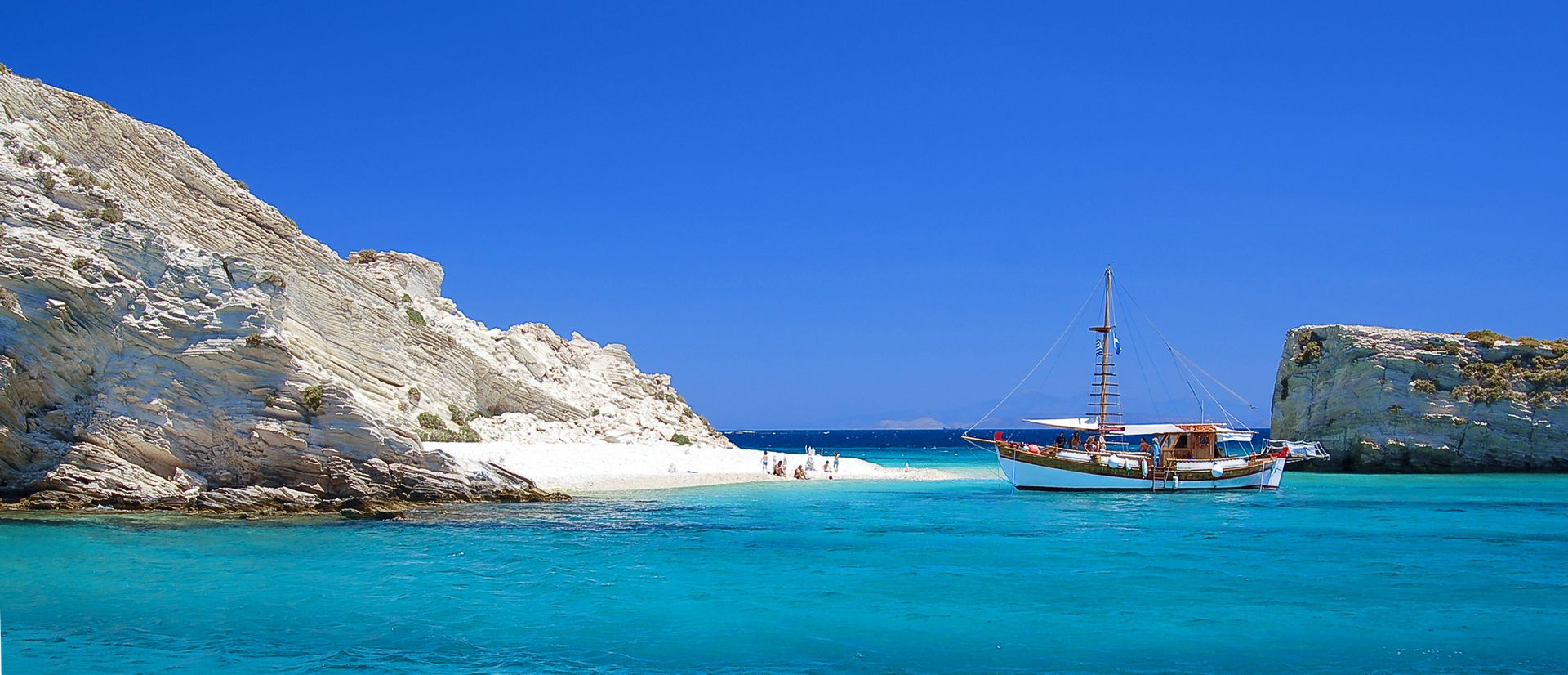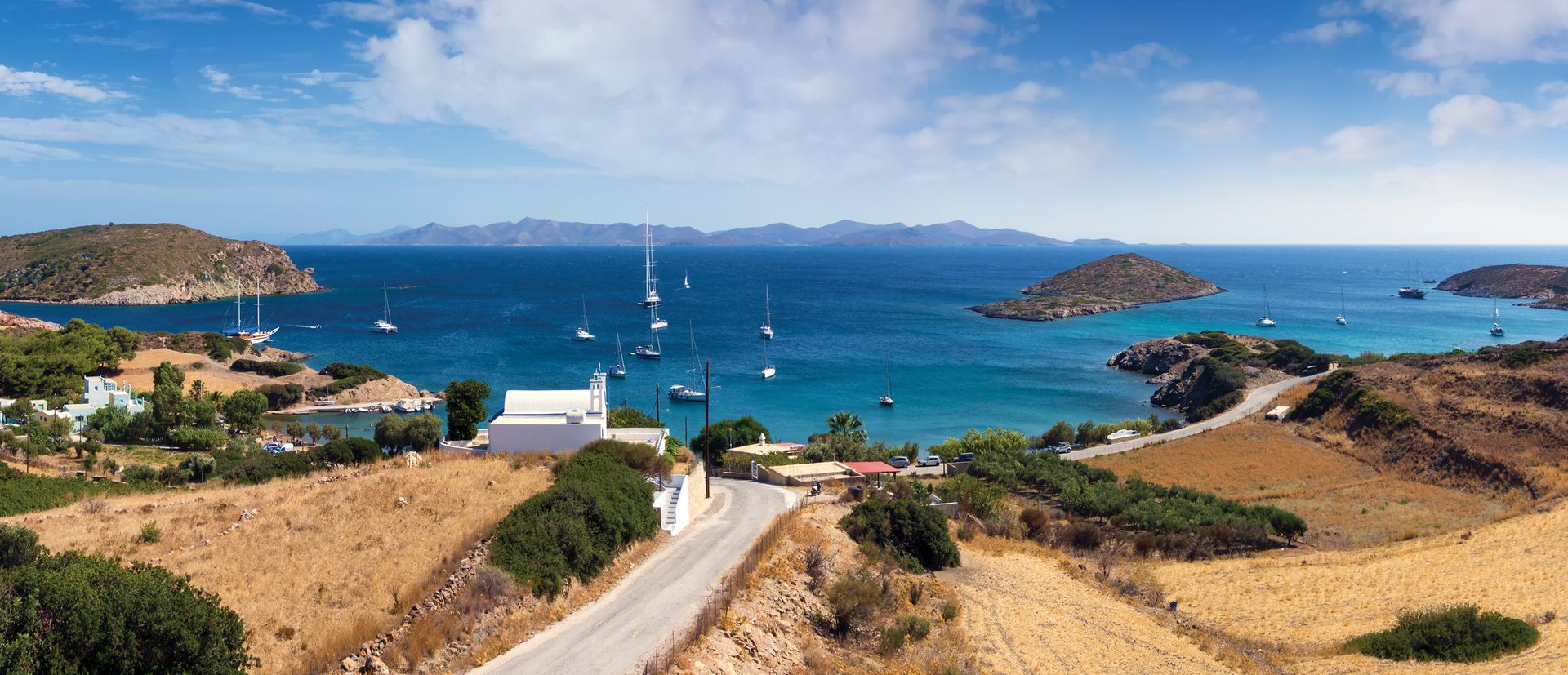A group of 30 small islets located on the north of the Dodecanese, between Patmos and Leros, consisting of 24 isles and 6 rocks, Lipsi, the biggest one of the group, adorn the southeast Aegean and invite you to discover them at your next trip. Ideal choice for those who seek for relaxation in nature and swimming in amazing beaches away from the crowds and mass tourism. Clear blue waters, untouched lacy shores and the bright light of the Aegean sun give unique beauty and grace to this small paradise land. Surrender yourself to the magic of this small island, walk in the fields with olive trees and taste the authentic island tastes with a view to the Aegean blue.
A touch of Mythology
The island of Calypso was Ogygia, the current island of Lipsi where Odysseus’ boat sank at his return to Ithaca, and remained as captive of Calypso nymph, who bewitched the mythical king white her irresistible charm and refused to let him go for 7 years.
Tour on the island
The basic colours of the island’s settlement are blue and white. Walk in the graphic alleys and visit the island’s monuments and meet the hidden secrets of the land. The majestic Church of Agios Ioannis located next to the town hall, with the two bell towers and the blue dome is worth visiting.
Walk in the paths and explore the virgin landscape
Hiking lovers will find graphic paths and alleys in the island that will guide you to exceptionally beautiful and rich flora and fauna areas. Follow the road from the Holy Church of Kimisis tis Theotokou up to the church of Ano Kimisi, or go up to the Mill and the Castle located on the highest spot of Chora and enjoy the most beautiful view to the vast Aegean blue and feel the serene island breeze.
Cruise with Rena to the exotic islands around
A one of a kind and unforgettable experience not to be missed! Cruise in unique places that remind of the Caribbean: turquoise waters, white beaches emerging in the middle of nowhere, rocky islets and caves and two small islands with few residents (Arkii and Marathi). The great hospitality of brothers Giannis and Thodoris who welcome you on their boat with a smile and pleasant mood will make your trip enjoyable as you will hear their stories and learn many secrets of the land.
Accompanied by pleasant music you will visit Aspronisia, Makronisia, Tiganakia, Arkious and Marathi.
Aspronisia: three rocks in the middle of nowhere, where you can walk from one to the other. Tall rocks, beaches with white thick and smooth pebble, a shallow crossing between the two islets and turquoise waters. A unique view that reminds of exotic places!
Makronisia: pass through an underground cave and reach a crater like the Blue Lagoon. There is also a cave at this point which you can cross by swimming!
Tiganakia: between the Eastern part of Arkii and Avaptistos, at the narrow sea passage with the turquoise, crystal waters you can swim and reach the rocky islets around while enjoying the natural beauty of a landscape that remains untouched by time, without any human intervention.
Marathi: a charming islet, with a coast and sandy beach protected by winds with three restaurants on the beach.
Arkii: a distant and deserted small island, ideal for absolute serenity and relaxation with restaurants available.
Beaches
- Katsadia: one of the most famous and beautiful beaches. Windless, with sand and turquoise waters, taverna and big trees offering shade.
- Tourkomnima: small, secluded cove with few trees, sand and magnificent crystal clear waters.
- Kampos: beautiful, oblong beach with many tamarisks, sand and clear waters.
- Platys Gialos: a beautiful and popular, windless small cove with shallow, turquoise waters, sand, tamarisks and a taverna.
- Lientou: one of the most famous beaches in Lipsi. It has sand, tamarisks for shade and crystal clear turquoise waters.
- Chochlakoura: one of the most beautiful beaches with turquoise waters, white pebbles and magnificent landscape. The beach does not have shade.
- Xirokampos: quiet beach with crystal clear waters with no shade.
- Papantria: a cove with clear blue waters, sand, thin pebble and reeds. The magnificent view to Lyra island composes a heavenly landscape.
- Monodendri: an exotic beach with turquoise waters, white pebbles and a tree standing on the rock create a landscape of unique beauty. The beach has quite difficult access and offers peace and tranquility.
Local products & delicacies
- Favokeftedes
- Kouloures
- Tiganopites
- Squid with black rice
- Cheese in olive oil or salted
- Spinialo (a conservation technique of bubble shell in sea water)
- Pitaroudia
- Xerotigano with honey, cinnamon and walnut
- Pantelis Taverna in Marathi is the ideal choice for those who love good food!

